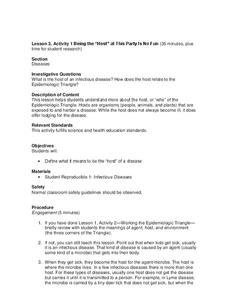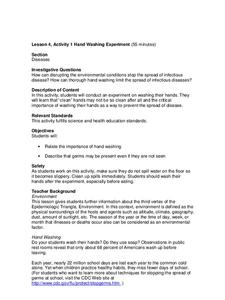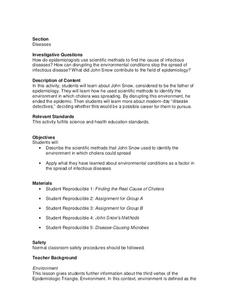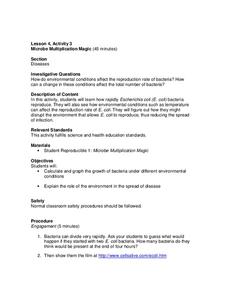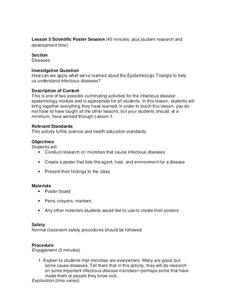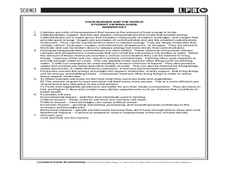Curated OER
Drugs Change the Way Neurons Communicate
Students examine that certain drugs interfere selectively with neurotransmission, and realize that the effect of a drug is dependent upon dosage and route of administration.
Curated OER
Voyage to Kure Viewing Guide
Students complete a worksheet while viewing a video about the oceans. They locate the oceans on a map and identify positive and negative ways in which humans have impacted them. They discuss any questions at the end of the lesson.
Curated OER
The Rising Cost of Health Care: Is there an explanation?
Twelfth graders explore rising health care costs and the Law of Diminishing Marginal Utility. They participate in an activity that demonstrates the Law of Diminishing Marginal Utility. Students read the may 27, 2005 Economic Letter and...
Curated OER
Media Awareness: the Basics of Advertising
Learners explore marketing techniques. For this media awareness lesson, students watch instructor-selected advertising and identify the marketing techniques used in each of them. Learners then create advertisements for products.
Curated OER
Backyard Bacteria
Young scholars demonstrate safe ways to handle bacteria, prepare agar plates, and grow bacterial cultures. They identify different kinds of bacterial colonies, and devise a controlled experiment.
Roald Dahl
The Giraffe and the Pelly and Me
Follow up a reading of The Giraffe and the Pelly and Me by Roald Dahl with this collaborative lesson on teamwork. Starting with a fun team game, learners go on to investigate examples of teamwork in the story before working in small...
Centers for Disease Control and Prevention
Being the “Host” at This Party is No Fun
Discuss the symptoms and variations from infectious diseases from one person to the next. After a class discussion, small groups complete research on the topic.
Centers for Disease Control and Prevention
Hand Washing Experiment
An engaging experiment allows scholars to understand why the recommendation is to wash for 20 seconds with soap and water — while making them aware of their own habits!
Centers for Disease Control and Prevention
Diseases
During a cholera outbreak, scientists presented two theories; one theory was based on miasma and the other on germs and contaminated water. The instructional activity looks at the scientific process for finding the real culprit.
Centers for Disease Control and Prevention
Microbe Multiplication Magic
A lesson introduces the reproduction rate of E. coli though a video. Then scholars complete a data table and graph of reproduction rates in ideal conditions as well as less than ideal conditions.
Centers for Disease Control and Prevention
Scientific Poster Session
An informative lesson offers young scientists the chance to research a microbe and create an epidemiologic triangle for a poster session and presentation.
Teach Engineering
Concentrated Solar Power
The seventh segment in an eight-part unit promotes the idea of concentrating the sun to increase the power of a photovoltaic panel. Pupils learn about devices used such as reflectors or lenses.
Curated OER
The Heart of the Matter
Upper elementary pupils learn about the blood transportation system and anatomy of the human heart. They fill in an outline of the human heart (not included) focusing on the flow of blood to and from the heart. Using stethoscopes, they...
Curated OER
Affecting Transportation Choices-Walk, Don't Ride!
Learners discuss methods of transportation they use and create a trip tally to determine which methods they use the most.
Curated OER
Labor Markets
Students examine labor markets by participating in an employer/employee simulation and in group discussions. They discuss mandated employee benefits and predict the effect they have on various parties.
Curated OER
Incentives, Profit and the Entrepreneur
Students discuss hypothetical problems associated with price and profit. They discuss the fairness of profit, how it should be measured, and the consequences of setting acceptable levels of profit.
Curated OER
Fast Food: You Can Choose!
Learners research the nutritional value of fast food. They assess which fast foods are best and worst to eat. They organize their data into tables and graphs and explain their findings to other students.
Curated OER
Transforming Food Energy: A Balancing Act
Students explain their role as consumers. They use a purchased calorimeter or make their own simple calorimeter to measure the energy content in selected foods. This interesting activity really gets students thinking about what they eat.
Curated OER
Decision Making and Teen Parenthood
Pupils inspect psychology by completing a worksheet in class. In this sexual health lesson, students discuss the responsibilities and maturity necessary in order to have a child and to also be sexually active. Pupils answer study...
Curated OER
Sexual Exploitation: Day 1: Communication
Students research and practice communication skills as assertiveness and listening in terms of sexual exploitation. For this communication lesson plan, students practice skills in 2 person teams.
Curated OER
Communication 3: Taking "No" For An Answer
Students play a rejection game and fill in sentences about taking and accepting "no" for an answer. In this taking "no" worksheet, students also discuss how asking more than twice is aggression.
Curated OER
Sexually Transmitted Diseases: Overview
Students observe human heath by completing a worksheet in class. In this STD lesson, students identify the different types of diseases which are spread through sexual intercourse and what symptoms will become noticeable. Students...
Curated OER
Communication 5: Defending Your Rights
Students role play situations where they communicate and defend themselves. In this communication lesson plan, students defend their rights by being assertive.
Curated OER
Student Self-Esteem
Students investigate human psychology by completing a worksheet in class. In this self-esteem lesson, students identify the importance of confidence in life situations and discuss why they should feel good about themselves. Students...








